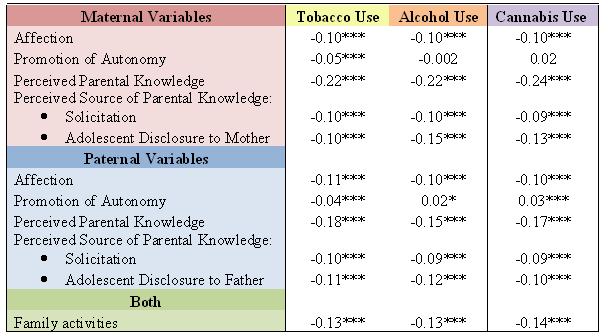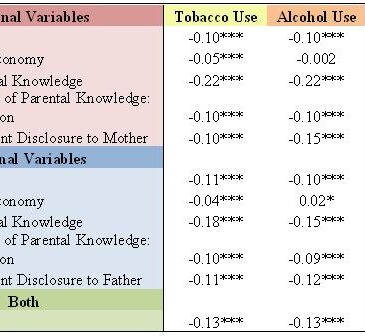Previous studies have shown that parent-child relationships and family dimensions can have a great influence on an adolescent child’s substance use (Hair et al., 2009; Bumpus and Rodgers, 2009). A lack of parental supervision makes adolescents particularly susceptible to substance use (Jacobson & Crockett, 2000). However, the specific family dimensions involved remain unclear. This week’s STASH reviews a study that identified the family dimensions and family members who are most important to preventing adolescent substance use (Jiménez-Iglesias, Moreno, Rivera, & Garcia-Moya, 2013).
Method
- The sample included 14,825 boys and girls from Spain between the ages of 13 and 18 who completed the Health Behaviour in School-aged Children (HBSC) survey (Klimidis, Minas, & Ata, 1992).
- In addition to tobacco, alcohol, and cannabis use, participants reported on both maternal and paternal family dimension variables, such as perceived parental affection, perceived parental promotion of autonomy, family activities, perceived parental knowledge, and perceived sources of parental knowledge.1
- The researchers analyzed which maternal and paternal family dimension variables were most relevant for tobacco use, alcohol use, and cannabis use separately.
Results
- Table 1 shows the correlations among family dimensions and substance use by parent gender.
- For the most part, all family dimension variables were associated with less substance use behavior.
- For example, adolescents who perceived their parents to be more affectionate and knowledgeable about their lives were less likely to report using tobacco, alcohol, and cannabis.
- Adolescents who perceived their fathers to be promoting their autonomy were less likely to use tobacco, alcohol, and cannabis. However, adolescents’ perceptions of their mothers’ promotion of autonomy was not associated with less alcohol and cannabis use.
- When both maternal and paternal variables were analyzed together, the most important family dimensions for adolescent substance use were mothers’ parental knowledge, adolescent disclosure to mothers, and family activities.

Figure. Family Dimensions and Substance Use by Parent Gender. Adapted from Jiménez-Iglesias et al. (2013). Note. *p<.05, **p<.01, ***p<.001. Click image to enlarge.
Limitations
- It is not possible to infer causal relationships between family dimensions and substance use in adolescents because the criteria for causality are not met.
- This study does not take into account that parental and adolescent relationships are dynamic and based upon the combined interaction of parental and adolescent influences.
- The authors of the study only used adolescents in their sample. Therefore, all variables measured are based on adolescent perceptions and may only reveal partial truth about the reality of parent-teen relationships.
- Many of the associations the researchers observed were small. They were statistically significant due to the large sample size and resulting high degree of statistical power.
Conclusions
The results of this study support the idea that family dimensions are associated with adolescent use of tobacco, alcohol, and cannabis. Parental knowledge, adolescent disclosure, and family activities were the strongest factors, and they might be important for a variety of reasons. For example, parental knowledge might reflect close, communicative relationships or the knowledge needed to protect adolescents from making harmful decisions, regardless of teen participation. Adolescent disclosure is important because this aids the ability of parents to guide safe decision-making. Family activities could limit substance use because parents can use this time to promote healthy attitudes and values. Though mothers might have a particularly strong opportunity to promote healthy attitudes related to substance use, this study shows that family dimensions, in general, are important to consider in adolescent substance use behavior.
– Melanie Mitchell
What do you think? Please use the comment link below to provide feedback on this article.
References
Bumpus, M. F., & Rodgers, K. B. (2009). Parental knowledge and its sources examining the moderating roles of family structure and race. Journal of Family Issues, 30, 1356-1378.
Hair, E. C., Moore, K. A., Hadley, A. M., Kaye, K., Day, R. D., & Orthner, D. K. (2009). Parent marital quality and the parent-adolescent relationship: Effects on adolescent and young adult health outcomes. Marriage and Family Review, 45, 218-248.
Jacobson, K. C., & Crockett, L. J. (2000). Parental monitoring and adolescent adjustment: An ecological perspective. Journal of Research on Adolescence, 10, 65-97.
Jiménez-Iglesias, A., Moreno, C., Rivera, F., & Garcia-Moya, I. (2013). The role of the family in promoting responsible substance use in adolescence. Journal of Child and Family Studies, 22, 585-602.
Klimidis, S., Minas, I. H., & Ata, A. W. (1992). The PBI-BC: A brief current form of the parental bonding instrument for adolescent research. Comprehensive Psychiatry, 33, 374-377.
- Perceived parental affection: “My mother/father helps me as much as I need/is loving/understands my problems and worries/makes me feel better when I am upset.”
- Perceived parental promotion of autonomy: “My mother/father lets me do the things I like doing/likes for me to make my own decisions/tries to control everything I do/treats me like a baby.”
- Family activities: Measured both the frequency that participants engaged in activities with the family, such as watching TV or eating a meal together, as well as enjoyment that adolescents received from these activities.
- Perceived parental knowledge: “How much does your mother/father really know about who your friends are/how you spend your money/where you are after school/where you go at night/what you do with your free time?”
- Perceived sources of parental knowledge:
- Adolescent disclosure: “In general, my mother/father knows about these things because she/he asks me directly and I tell her/him.”
- Parental solicitation: “In general, my mother/father knows about these things because I tell her/him spontaneously, even if she/he doesn’t ask.”




